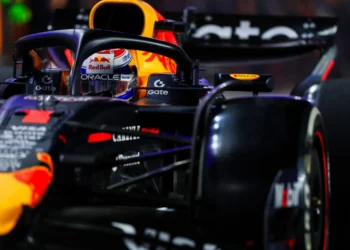Unveiled: The Shocking Physical Stats of F1 Drivers in 2025
In the high-stakes world of Formula 1, every inch and every pound can make or break a driver’s performance on the track. The recently revealed height and weight chart of F1 drivers for the 2025 season provides a fascinating glimpse into the physical diversity of the sport’s elite competitors.
From the compact and agile Yuki Tsunoda to the towering figures of Esteban Ocon and Alex Albon, the size of these drivers plays a crucial role in shaping the dynamics of their cars. In a sport where every detail is meticulously scrutinized for optimal performance, a driver’s physical attributes can significantly impact the handling, aerodynamics, and weight distribution of an F1 car.
Standing tall at 1.86 meters (6’1”), both Esteban Ocon and Alex Albon dominate the height chart for the 2025 season. On the opposite end of the spectrum is the diminutive Yuki Tsunoda, measuring just 1.59 meters (5’2”) and weighing a mere 54kg, making him not only the shortest but also the lightest driver on the grid. While these differences may appear insignificant to the casual observer, they can have tangible effects on the comfort and performance of the drivers behind the wheel.
The weight list is topped by Nico Hülkenberg at 78kg, leveraging his robust build for stability and power on the track. Meanwhile, seasoned champions like Lewis Hamilton (1.74m/73kg) and Max Verstappen (1.81m/72kg) strike a balance between agility and control, showcasing the diverse physical profiles of F1 drivers in the current season.
In the cutthroat world of F1 racing, where milliseconds can determine victory or defeat, every aspect of a driver’s physique matters. The 2025 season brings to light the intricate interplay between height, weight, and performance in the quest for racing glory.
—
Rivelato: Le Sorprendenti Statistiche Fisiche dei Piloti di F1 nel 2025
Nel mondo ad alta tensione della Formula 1, ogni centimetro e ogni chilo possono determinare o meno la prestazione di un pilota in pista. La recente rivelazione della tabella di altezza e peso dei piloti di F1 per la stagione 2025 offre uno sguardo affascinante sulla diversità fisica dei concorrenti d’élite dello sport.
Dallo snodato e agile Yuki Tsunoda alle figure imponenti di Esteban Ocon e Alex Albon, la grandezza di questi piloti gioca un ruolo cruciale nel plasmare la dinamica delle loro auto. In uno sport dove ogni dettaglio è meticolosamente scrutinato per prestazioni ottimali, le caratteristiche fisiche di un pilota possono influenzare significativamente la maneggevolezza, l’aerodinamica e la distribuzione del peso di una vettura di F1.
Con un’altezza di 1,86 metri (6’1”), sia Esteban Ocon che Alex Albon dominano la classifica di altezza per la stagione 2025. All’estremo opposto dello spettro c’è il minuto Yuki Tsunoda, che misura solo 1,59 metri (5’2”) e pesa appena 54 kg, rendendolo non solo il più basso ma anche il più leggero pilota sulla griglia. Sebbene queste differenze possano sembrare insignificanti per l’osservatore occasionale, possono avere effetti tangibili sul comfort e sulle prestazioni dei piloti al volante.
La lista dei pesi è guidata da Nico Hülkenberg a 78 kg, sfruttando la sua corporatura robusta per stabilità e potenza in pista. Nel frattempo, campioni esperti come Lewis Hamilton (1,74 m/73 kg) e Max Verstappen (1,81 m/72 kg) trovano un equilibrio tra agilità e controllo, mostrando i diversi profili fisici dei piloti di F1 nella stagione attuale.
Nel mondo spietato delle corse di F1, dove i millisecondi possono determinare vittoria o sconfitta, ogni aspetto della fisicità di un pilota conta. La stagione 2025 mette in luce l’intricato intreccio tra altezza, peso e prestazioni nella ricerca della gloria nelle corse.
“`html
Man mano che la battaglia per la supremazia si intensifica in pista, diventa evidente che le caratteristiche fisiche non sono solo una nota a margine nella narrativa della F1, ma un componente cruciale dell’equazione competitiva. In uno sport dove la perfezione è l’obiettivo finale, la ricerca della misura perfetta si estende oltre la potenza e la strategia alle stesse dimensioni fisiche dei piloti.
La stagione 2025 di Formula 1 non è solo uno scontro di velocità e abilità, ma anche una vetrina di come la giusta combinazione di altezza e peso possa inclinare la bilancia a favore della vittoria.
“`










